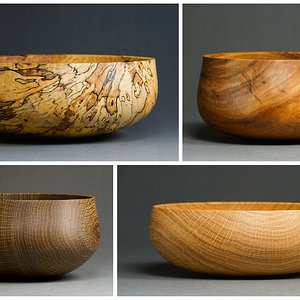In between projects that require a lot of embellishment or otherwise off-lathe time, it's really satisfying to turn some bowls. These are a few calabashes that I've turned recently, and they represent some of my favorite native Tennessee hardwoods. Moving clockwise: The upper left is heavily spalted Pecan, 9.5"d x 3.5"d. The upper right is slightly spalted Black Cherry that I lightly fumed with ammonia, 6.25"d x 3.25"h. The lower right is a small Black Oak calabash, 5.25"d x 2"h. The lower left is White Oak that I heavily fumed with ammonia, 6.75"d x 3.5"h.








